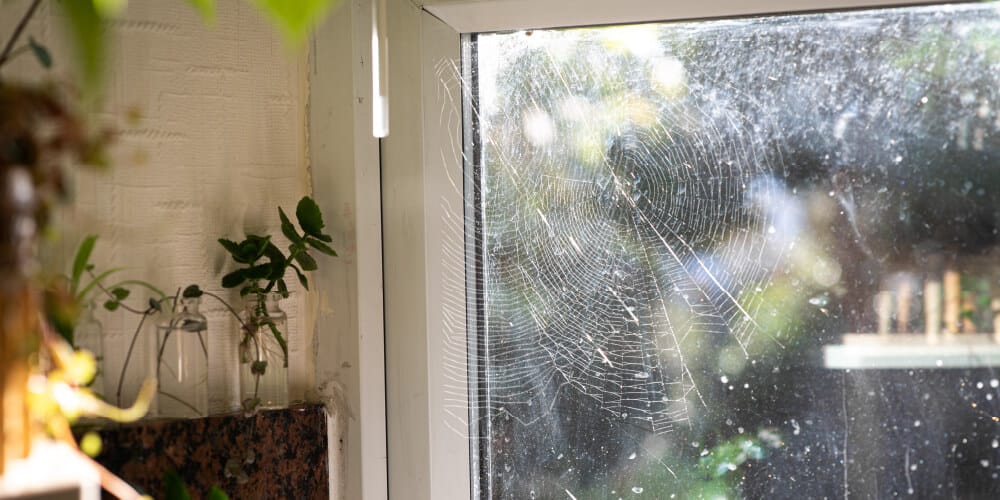Whether they spark a sense of fascination or send chills down your spine, spiders are a common pest that can find their way into your home. These silent lurkers can invade your space without you even knowing, taking up residence in quiet corners or hidden spots. Understanding how spiders live and what attracts them to your home is the first step in keeping them away.
Spiders, much like other pests, are generally attracted by three basic elements:
- Something to eat
- Something to drink
- Somewhere to live
Understanding these three pillars can empower you to effectively manage spider issues in and around your home, with the expert assistance from Aptive. Knowing why spiders find your living space attractive can guide you to focus on eliminating the food, water, and shelter that draw them in.
A Steady Food Supply
Spiders are predators that feed on insects, which means their presence might indicate a larger pest problem in your home.
With their intricate webs and stealthy hunting tactics, they play a crucial role in the ecosystem by controlling insect populations. However, when they encroach upon our living spaces, they can become unwanted guests. To adequately manage spider populations, it’s imperative to understand what and where they eat.

Inside
If spiders are consistently found indoors, it likely means they have found a food source inside. They might be catching other small pests such as flies, mosquitoes, or ants in their webs. Addressing the problem of these prey insects can, in turn, reduce the spider population.
Several common indoor arachnids are skilled web builders. They primarily feast on small insects like flies, mosquitoes, and moths that become ensnared in their webs. House spiders often stake their claim in quiet, undisturbed corners of our homes. Some are often found in damp, dark areas like basements, pantries, or cellars.
Spiders are also agile hunters. They actively stalk and capture a variety of insects, including ants, beetles, and even other spiders. Their keen eyesight and hunting prowess sets them apart as well. Unlike their web-spinning counterparts, these spiders actively pursue their prey, which may include flies, ants, and even small moths.
Outside
Outdoors, spiders often find a feast waiting in mulch beds, piles of leaf litter or any debris, and near outdoor lighting where other pests gather. They might be attracted to areas with high insect activity, such as around compost bins or places with stagnant water that attract mosquitos. The most obvious attraction to spiders around a home is near light fixtures and windows with light beaming out from your house.
Several outside arachnids are masters of constructing intricate circular webs. They target flying insects such as flies, bees, and wasps, making gardens and flower beds prime hunting grounds.
Lots of ground spiders are also great hunters. They pursue a wide range of insects, including beetles, crickets, and grasshoppers, in gardens, grassy areas, and under stones.
Some, who are ambush predators, are often found on flowers, where they patiently await their prey. They target pollinators such as bees, butterflies, and other insects attracted to nectar-rich blooms.
To manage spider populations effectively, a combination of preventive measures and targeted interventions is essential. Regular cleaning to remove webs and hiding spots, sealing entry points, and reducing outdoor lighting can deter spiders from establishing themselves in your home. Additionally, encouraging natural predators like birds and predatory insects can help keep insect populations in check, reducing the food source for spiders.
For persistent infestations or species causing notable concern, seeking the expertise of a professional pest control service is highly recommended. Trained technicians can employ targeted treatments and provide expert advice on long-term spider management strategies.
Available Water Sources
Spiders get most of their moisture from their prey, but they also need access to water, and they can find it in unexpected places in and around your home.
While spiders are known for their impressive hunting skills, their water needs are often overlooked. Understanding where and how spiders quench their thirst can provide valuable insights for impressive pest control strategies.
Unlike mammals, spiders don’t drink water in the traditional sense. Instead, they absorb moisture through a process called “osmosis”. This means they can extract water from the environment around them, making them highly adaptable to different habitats.
Inside
Within homes, spiders may find moisture in damp areas such as basements, under sinks, or in bathrooms. It’s vital to manage moisture levels in your home to make it less attractive to spiders.
Within homes, spiders can find the moisture they need in various unexpected places. Damp corners, basements, and even condensation on windows can provide sufficient hydration. Leaky pipes, clogged drains, or areas prone to condensation can create a conducive environment for spiders.
To mitigate indoor spider activity, it’s essential to address any water-related issues promptly. Repairing leaks, improving ventilation, and reducing humidity levels can help deter spiders from seeking water sources inside your home.
Understanding spiders’ hydration habits complements broader pest control efforts. By addressing both food sources and water availability, you create a space less hospitable to these arachnids.
Outside
Outside, you’ll most commonly find spiders around damp areas of the home. These locations have 3 attractive features: comfortable humidity, plentiful food supply, and an available water source.
Outside, spiders have an even wider array of options for hydration. Gardens, lawns, and outdoor structures can provide the necessary moisture. Morning dew, rainwater collected on leaves and plants, as well as small puddles or moisture-rich soil can all serve as water sources for spiders.
To minimize spider activity around your property, it’s advisable to manage moisture levels effectively. Regularly inspect outdoor areas for potential water accumulation and ensure proper drainage to prevent standing water.
Secure Shelters
Anywhere with at least two surfaces to anchor a web can be a place of residence for spiders. Any location with other insects and a hiding place can serve as territory for spiders that hunt or ambush. Spiders are drawn to quiet, undisturbed areas where they can build their webs and reside peacefully.
Understanding where spiders choose to dwell is essential for effective pest control. These arachnids are highly adaptable and can be found in a variety of environments, both indoors and outdoors.
To effectively manage spider populations, it’s crucial to address their preferred habitats. Regular cleaning and decluttering of indoor spaces can remove hiding spots and disrupt existing webs. Sealing entry points, such as gaps around windows and doors, can prevent spiders from gaining access to your home.
For persistent spider problems or species of particular concern, seeking professional pest control services is recommended. Experienced technicians can conduct thorough assessments and implement targeted treatments to address the root causes of infestations.
Inside
Within your home, spiders often favor secluded areas such as attics, behind furniture, or in the corners of the ceilings and the basement, where they find the peace and security to spin their webs or hunt for prey. This is why our Service Professionals will focus on these areas when treating inside.
Spiders are adept at hiding in corners where walls meet ceilings or floors. These areas provide them with a vantage point for constructing webs and ambushing prey.
Dark, undisturbed spaces like closets and storage rooms offer spiders a safe haven. They can often be found among stored items or in the corners of these spaces.
These areas tend to be cool and damp, creating favorable conditions for spiders. They often seek shelter in boxes, behind insulation, or in corners.
Spiders may take advantage of the gaps around windows and doors, where they can construct webs to catch insects attracted by light.
Outside
Outdoors, they may find refuge in overgrown vegetation, within piles of wood or leaves, and in the nooks and crannies of garden features. Keeping your yard tidy and reducing clutter can deter spiders from settling.
Outdoors, maintaining well-trimmed vegetation and keeping outdoor areas free of debris can reduce spider-friendly environments. Additionally, sealing cracks in outdoor structures and using screens on windows and vents can help prevent spiders from establishing themselves.
Outdoor spiders find ample prey in gardens due to the high concentration of insects attracted to plants. They often build webs in shrubs, flowers, and tall grass.
These sheltered areas provide spiders with protection from the elements and a vantage point for hunting insects that venture too close.
Spiders seek cover in vegetation, where they can easily construct webs and ambush unsuspecting insects.
Some ground-dwelling spiders, like wolf spiders, prefer hiding under rocks, logs, or in leaf litter.
Points of Entry
To limit spiders from coming in, consider their points of entry into your home. Sealing cracks, gaps, and holes in the walls, windows, and doors can be a potent preventative measure. Regular maintenance and inspections can help you identify potential entry points and address them promptly.
Where Are Spiders Found?

With Aptive’s nationwide pest monitoring, we understand the habitats of different spider species across the US. From urban to suburban areas, spiders can be found exploiting the comforts of human environments to satisfy their basic needs. Knowing where they are most commonly found can help in devising impactful control strategies.
When Are Spiders Most Active?
While spiders are always present, they are known to be more active during specific seasons, with a notable increase in activity during the summer and fall. Understanding their behavioral patterns can aid in timed proactive measures.
The Aptive Approach to Spider Control
Managing a spider problem goes beyond mere sightings; it involves addressing the conditions that allow spiders to thrive in the first place. By tackling the issues at the source and creating an integrated pest management plan with Aptive, you can defend your home against spider infestations.
Inside
Focusing on potential hiding spots and frequently cleaned areas can prevent spiders from settling in. Consider placing traps in strategic locations to catch wandering spiders. Regular cleaning and vacuuming can also eliminate webs and egg sacs, disrupting their lifecycle.
Outside
Pay attention to potential entry points to your home and shelter spots in your yard and around the exterior of your home. Maintaining a clean and tidy outdoor space can deter spiders from nesting.
Conclusion
While spiders play a crucial role in controlling pest populations, their presence inside your home can be unsettling. Understanding where they live, what attracts them, and when they are most active can be the key to managing spider problems with efficacy.
At Aptive, we believe in taking a comprehensive approach to pest control, and our method of tackling spider infestations is no exception. Our highly skilled Service Professionals meticulously inspect the home and property during treatment, identifying areas of spider activity and potential points of entry. We then apply extensive spray treatments to target areas of your home that are most affected by these pests.
Unlike many other services that simply sweep away spider webs, our team goes above and beyond to mitigate the presence of spiders. We sweep down webs from eaves, around doors and windows, light fixtures, downspouts, and corners, as well as meter boxes—essentially, anywhere a spider might anchor a web.
We also spray bushes and shrubs both on and inside them, treat the foundation to bolster your home’s defenses against spider invasion, and target the yard from home to curb and fence line to reduce spiders in the yard. The Aptive team also communicates with you about our findings and offers advice on what you can do to help reduce the problem further.
Don’t let spiders disrupt your peace of mind; reach out to us today and join others who have entrusted us with their pest control needs.








